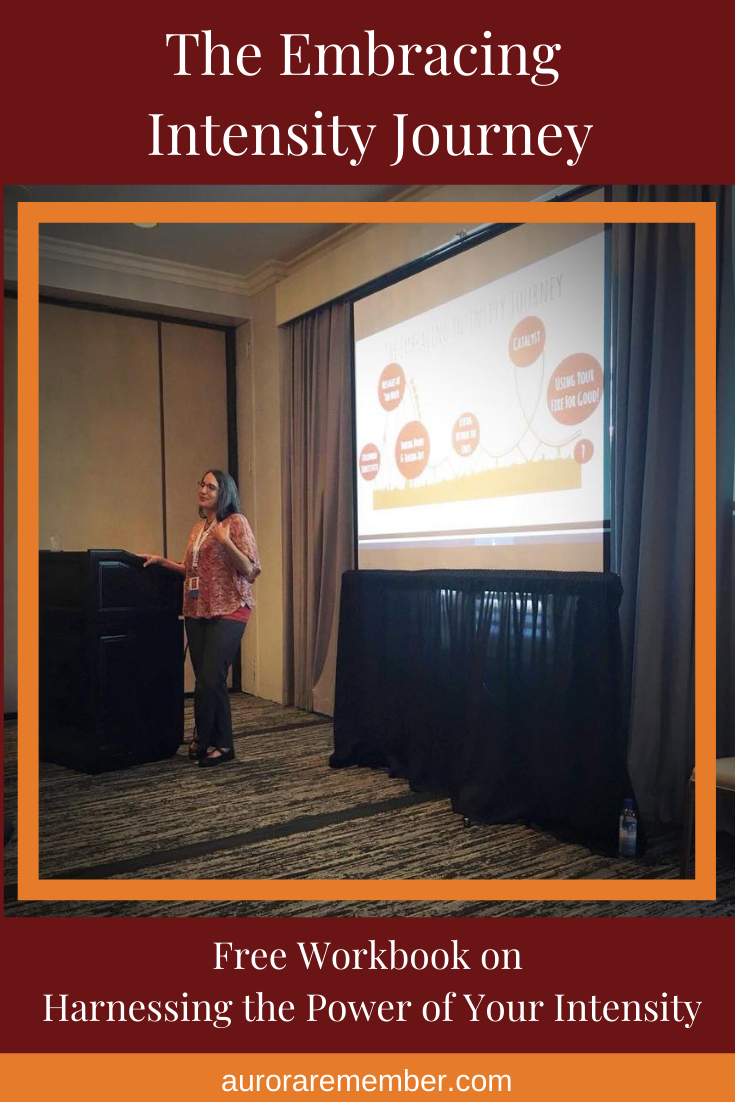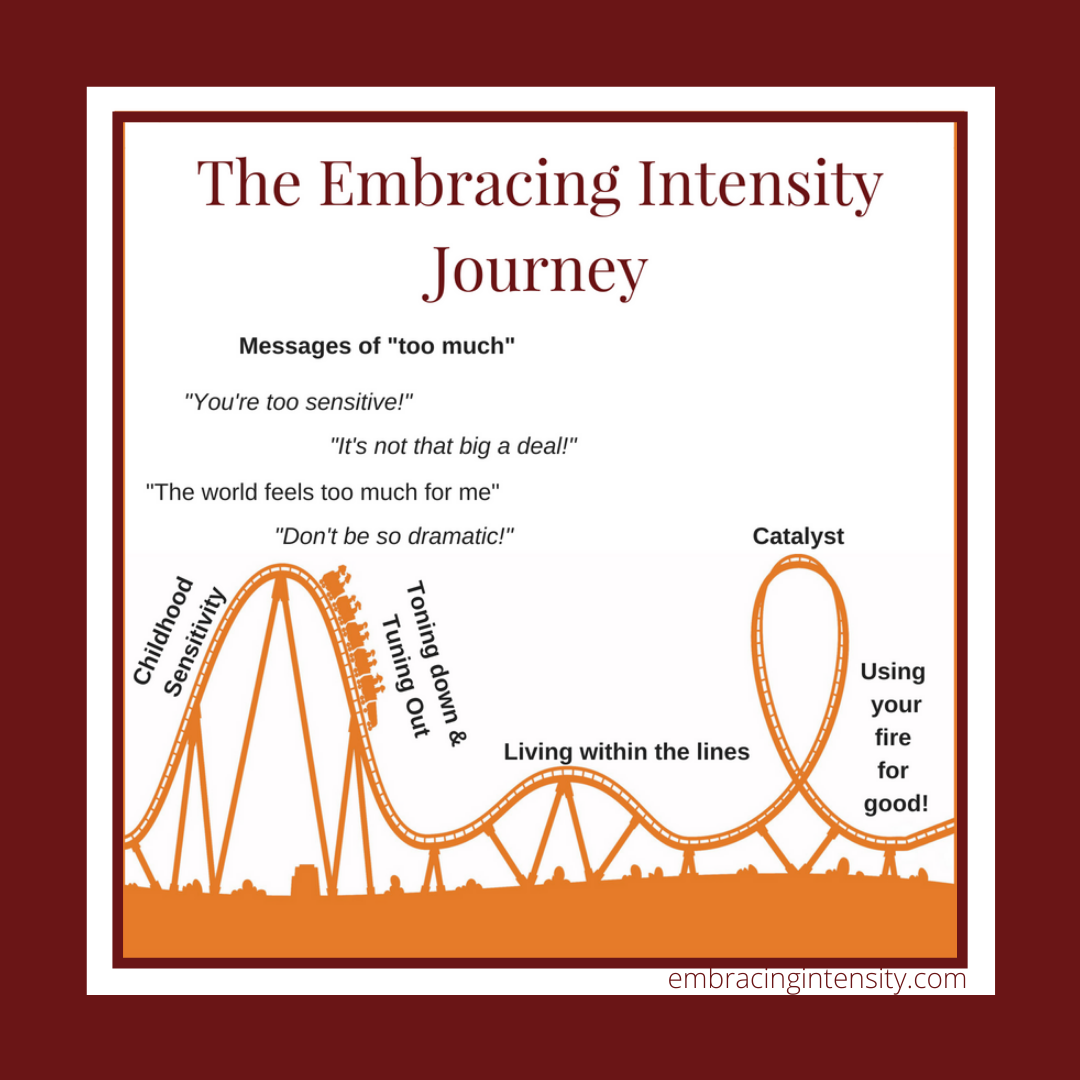Four years ago in October, I started the Embracing Intensity Podcast, interviewing around 100 gifted, creative and outside the box thinkers about how they use their fire in a positive way. Two years ago, I got to present my observations on common themes in the Embracing Intensity Journey at a conference on Supporting the Emotional Needs of the Gifted (SENG). Since then, I started the Embracing Intensity Community, and was formally diagnosed with ADHD. The themes I picked up on have continued to ring true, but I also started picking up another theme that a lot of the folks I was interviewing were also twice-exceptional (gifted + disabled/neurodiverse). It makes sense that I would be drawn to folks who are not only gifted, but have experienced some barriers in their lives to achieving their full potential! I shared my talk on the podcast at the time, but I thought it was a good time to revisit it with a post on my experiences and observations of the Embracing Intensity Journey!
The Embracing Intensity Journey
When my son first started in school, I looked up giftedness and behavior problems to see if I could gain more insight on how to support him have a successful school experience. That is when I discovered the concept of over-excitability and recognized many of the traits in myself. That led me down the path to help highly excitable adults use their fire in a positive way by interviewing others who were channeling their intensity superpowers for my Embracing Intensity Podcast and creating a self-regulation course called Ignite Your Power.
One of the great things about interviewing gifted, creative and outside-the-box thinkers is that no two stories are alike! Within those stories though, I have noticed common themes on the path to using intensity in a positive way.

Childhood Sensitivity
Many gifted and intense people feel like a square peg in a round hole. In my family, we were all square pegs! For families like mine, it can be comforting to have other people who understand you, but on the other hand it leaves a lot of room for creative chaos! Other, more achievement oriented families put pressure and expectations on their kids to succeed.
Mely Brown, formerly of Self-Care for Sensitive Women, likened her sensitivity to trying to “put all of Niagra Falls through a straw.”
The experience of intensity can be found in all cultures and communities, but culture of origin can have a large impact on what aspects of intensity you can express. These factors are infinite, but some influential patterns I’ve observed include how individualistic a community is, and whether there is an anti-intellectual bias. Religion can play a significant role – both in supporting intensity and in pushing to suppress it.
Lucinda Leo and Simone de Hoog, who worked together at Powerwood, both expressed that using the term “gifted” in the UK was considered taboo, so they address that community through focusing on the aspect of over-excitability, which seems to be more socially acceptable.
Messages of “Too Much”
Gifted and intense people simultaneously get messages of “too much” and “not enough.” For me, I was “too talkative,” but also “not living up to my potential.”
That feeling of “too much” can come internally or externally. When the world feels “too much,” you may start trying to tune things out. When the world thinks you are “too much,” you may start to tone yourself down.
Amy Pearson, of Live Brazen, talks about her years of approval addiction and chasing gold stars. It wasn’t until she stopped focusing on achievement for others and started focusing on achievement for herself that she really connected with the people who really “got” her.
Toning Down & Tuning Out
Because little annoyances were uncomfortable for me, and uncomfortable things were painful, I learned at an early age to start tuning out my body, which eventually manifested in chronic pain I could no longer tune out. I toned myself down in my first marriage as a part of “maturing,” but began to loose some of myself in the process.
Common ways of tuning out include getting up in your head, tuning out your body entirely and getting consumed by busyness. Although it may be tempting to change or town down to “fit in,” the result often leads to a feeling of social isolation and loneliness and losing track of one’s self-identity.
Leela Sinha, author of “Your Not Too Much,” notes that “if you ‘toned it down’ and found yourself in a place where you sort of fit, as your toned down self – the odds are, you’re going to get sick of it and you’re going to bust out of that box,” so, “the less time you spend building yourself into a false reality, the better off you are.”
Living Within The Lines
For years I followed the expected path. I got married, got an advanced degree and worked in the schools at a job that I was good at and was moderately fulfilling. I believed that the adult thing to do was get a “day job” and any other interests become a hobby.
Living within the lines can occur internally, with the feeling that no one will ever “get” you. It can often lead to escaping through books, learning or creative pursuits. For those that seek validation externally, it can lead to approval addiction and a loss of true self.
For Nisha Supahan, living within the lines took the form of supporting her whole family in their own endeavors. Now she is on an adventure of finding her own passions and interests.

Catalyst
At the point where I met most of my adult “goals” – getting married, working in a career that mostly suited me, participating on a community theatre board and had my first child, I found myself suddenly a single mom reexamining everything I had taken for granted.
Catalysts can take any form, but some common ones include some sort of “aha” moment or self-realization, a life crisis, or some other form of positive disintegration where you feel like your life is falling apart only to come together into a stronger whole.
Angela Rose Fields, Shamanic Healer and Coach, noted that for her, the catalyst looked like a mental health breakdown as she started to connect more deeply to both herself and the world around her.
Using Your Fire For Good!
The last ten years for me has been a process of getting to know myself better so that I can help others do the same. Moving from doing things because I think I “should” to consciously choosing what I do and knowing the reason behind it. When I make a choice that does not turn out as expected, I am forgiving of myself because I know the basis of my decisions, even if the outcome did not turn out as expected.
The path to using your fire in a positive way often starts with a period of self-reflection. Some common tools used for self-reflection include exploring purpose and values, self-education through classes and books, journaling, mindfulness and meditation, time in nature and any kind of creative expression. Understanding where we are at can help us to move consciously into the direction we want.
When we experience the world more intensely than others, we can experience stress more intensely as well. Understanding how to regulate our stress and energy levels is a crucial part of maintaining the energy it takes to maximize our potential. There are 5 main areas of stress and energy balance: physical, mental, emotional, social and spiritual. It can be helpful to look at each of these areas and see what activities in our day-to-day life are energizing and which we find draining. Then we can make conscious efforts to increase the energizing activities and decrease the stressful/draining ones.
One way to decrease stressful and draining activities and increase energizing ones is to develop healthy personal habits. Rather than focusing on doing the things we “should” do, it is helpful to start with practices we “want” to do. This makes the activities inherently more energizing. Some personal habits I’ve observed that have been helpful include self-reflection habits, such as journaling and gratitude practices, positive health habits, developing rituals & routines, automation of repetitive tasks and delegation of tasks that are not energizing.
While all of those strategies have helped me in a positive way, getting a formal diagnosis and treatment for ADHD has helped me have the energy to better maintain them. Not understanding ADHD and executive functioning challenges was difficult in school, but when I self diagnosed ADHD 24 years before getting the final diagnosis, I was able to use the knowledge I had gained of how I think and learn to better understand myself. This is why I went into school psychology in the first place, and am now using my knowledge to help gifted and twice exceptional adults figure out how they think and learn so they can use their strengths instead of pushing against their weaknesses.
Colin Seale, of Think Law, shares about his own experience with being identified gifted with undiagnosed ADHD. Teachers would always say, “Colin is gifted BUT…” and now his aim is to help teachers see that it’s not BUT but, “Gifted AND!”
For Chris Wells, of the Gifted Development Center, learning about twice-exceptionality helped her realize she was not broken, and in fact she had a lot of strengths she could use for her own positive development.
A final component that has been infinitely helpful in helping gifted and outside the box thinkers is finding community who understand them. For me, this was found through the Unitarian Universalist community and local Community Theatre, networking groups and online communities. More recently I created my own Embracing Intensity Community.
Other places people have found connection include educational outlets, creative outlets, social justice, spiritual communities and other common interests.
Paula Prober, of Your Rainforest Mind, notes Argentine Tango as an excellent outlet for connecting with gifted and creative thinkers.
Based on my experience and observations over the years, I created a self-regulation course called Ignite Your Power, which I am currently updating in the Embracing Intensity Community to include newly revised workbooks. You can find all completed workbooks in the community, and also in my online store. This month’s workbook on Finding Meaning in Challenge is 50% off until the end of the week, and the first book in the series on Harnessing the Power of Your Intensity is always free.
